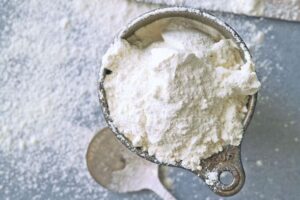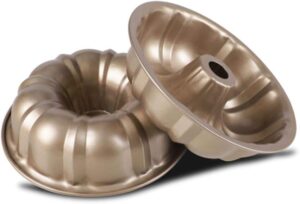At Fabulous Foodie, we’re always excited when the latest series of Great British Bake Off is underway. And we find ourselves, during the run, thinking and discussing baking with much more frequency. Possibly you do as well. Which is why we thought these little tips might come in handy.
Start at the Start

I’ve said it before, I will say it again and I will keep saying it until I go to the great big bakery in the sky: Always make sure to read through a recipe before you do anything else. Yes, from start to finish, all the ingredients and instructions. Nothing will upset the apple cart and ruin the apple cobbler like discovering mid-bake that you are missing a vital ingredient or piece of equipment.
Taking Measure
Are you scooping your flour directly out of the bag with your measuring cup? You may not be doing yourself or your baking any good. The flour will get compacted that way. Always spoon the flour into the measuring cup and then run a knife over the top to level it.
Brown sugar on the other hand should be compacted. One cup brown sugar means a packed cup so press down a bit to make sure you’ve got as much as possible into a level cup.
Speaking of brown sugar – have you discovered the brown sugar in the pantry has gone hard? No problem. Place it in a microwave-safe bowl with a damp paper towel on top and zap it for 20 seconds at a time until it’s softened up the way you want.

Gettin’ Greasy
Want to make sure you’ve greased every nook and cranny of that baking tin with butter? Forget using a piece of butter in paper. Too easy to miss spots that way and doesn’t always make it into corners. Try using a pastry brush instead. Just run the brush over soft butter then swipe it around the tin. I find that it covers better than the paper and goes on faster.
Another top greasing tin tip — learn from my mistakes and remember that when using a bundt pan, greasing the bottom and sides is all well and good but get the center bit also. Trust me. *shuffles embarrassingly at the memory*

Chill out and warm up
You’ve remembered to soften the butter but did you remember to take the eggs out of the fridge to warm up? Those of you in the UK will quite likely be wondering why on earth the eggs were in there in the first place – that’s another discussion for another time – but to those of you in the US, trust me. Room temperature eggs emulsify and combine with other ingredients much better than cold eggs. Get those puppies out of the chiller for a couple of hours.
If you forget and need the eggs warmed up quickly, place them in a bowl of warm water for five minutes.
Play It Cool
A lot of recipes offer cooling times, but if they don’t and you’ve got a warm sponge on your hands – a good rule of thumb for sponge cakes is leave it to cool in the tin for 5 minutes then turn it out onto a cooling rack to cool the rest of the way. This ensures you don’t end up with slightly soggy edges. If there’s an overabundance of fruit in the cake in question, leave it to cool in the tin. Those fruits carry a lot of moisture and can cause “cake spread” otherwise.

Beat Your Bake
In many cake or cookie recipes, instructions say to cream the butter and sugar. This does not mean to mix them together for just a minute or two – this means to beat with a beater or in a mixer (or stir rapidly and briskly) until the butter grows lighter in color and texture. Doing so incorporates more air into your mixture and gives you bake more lift.
Floury Fruit
When making a fruit cake, you want the fruit to be distributed throughout the cake not just settled at the bottom. To help ensure an even distribution, dust dried fruits (such as raisins, dried cranberries or blueberries) with a bit of flour before adding them into the mix.
Just What You Knead
You don’t want to use too much extra flour when kneading or your dough will dry out – and that can mess up your crust formation. If the dough is sticky, try lightly oiling your hands first and see if that doesn’t make things easier. Some people find a dough scraper useful and while we have a dough scraper and it is one of the most used tools in our kitchen, ironically we have never used it on dough. Go figure.

Get Cracking
I am about to make a suggestion I know will be greeted with a few rolled eye. HOw do I know? Because I had the same reaction when I first heard it. But via the hard knocks of baking experience, I’ve come around and I say to you: Crack your eggs into a separate bowl first and then incorporate them into your mixture. Even if your recipe says to add one egg at a time. Crack it into the egg bowl, the from there into the mixture.
Yes, yes, I know it creates one more bowl to wash up but trust me. You just never know when you might get a bad egg – it doesn’t happen often but it does happen. It happened to me. Using the separate bowl means that should a bad egg or utterly splintered shell come your way, the only thing you’ve lost is an egg or two, not your whole mixture. Even if you are rolling your eyes now, you will thank me later.
So Close and Yet So Far
It’s frustrating when you realize that you are one ingredient away from having everything you need. Here’s some swaps that mean you can avoid the shops and still get your bake on.
- Need self-raising flour but only have plain? Just add 2 tsp of baking powder to every 200g (8oz) plain flour and presto! Self-raising flour.
- Need buttermilk but failed to pick it up when you shopped for everything else? Stir 1 tablespoon of lemon juice or white vinegar into 1 cup of milk. Let the mixture sit at room temperature for 5 or 10 minutes, then use as you would do store-bought buttermilk.
As always, I hope these tips and tricks are useful should you find yourself in a baking way and I hope you’ll share your baking tips with the rest of us. I’ll be putting more up as we get closer to GBBO day.
And as always, if you have any tips or tricks you’d like to share – please feel free. We’re always looking for ways to mix it up in the kitchen.
